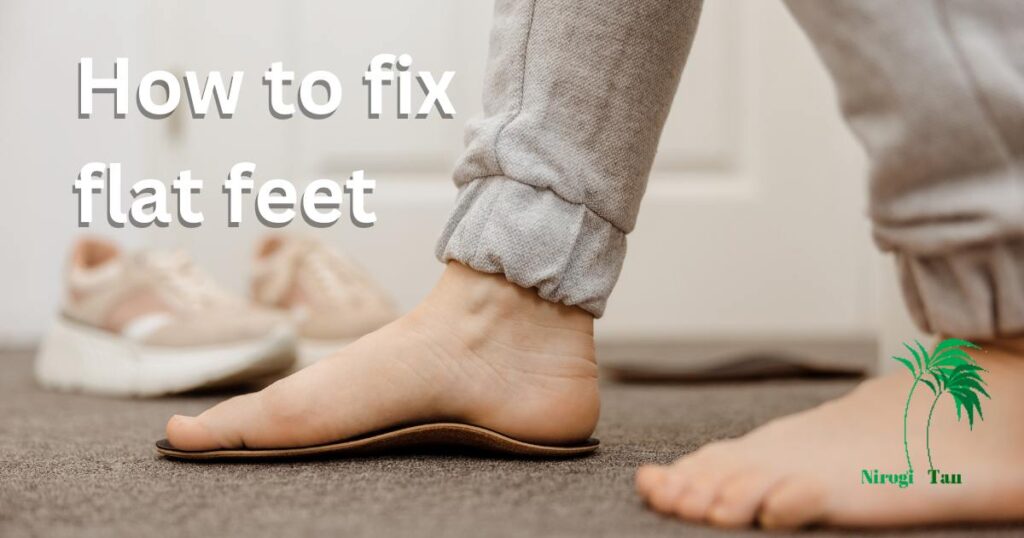Millions of individuals all over the world suffer from flat feet, commonly referred to as fallen arches. The feet’s arches either completely or partially collapse under the influence of this illness, giving them a flattened appearance. Flat feet can make it difficult to engage in some physical activities and can also cause pain and discomfort in the feet, ankles, knees, hips, and lower back.
Fortunately, flat feet can be corrected in a variety of ways. There are numerous efficient methods to strengthen the arches of the feet and lessen pain and suffering, ranging from basic exercises and stretches to more sophisticated procedures. We’ll look at some of the best ways to treat flat feet and enhance foot health in this article.

Recognising Flat Feet
Prior to learning how to treat flat feet, it’s critical to comprehend what creates the problem. Numerous variables, such as heredity, ageing, injuries, and specific medical disorders, can contribute to flat feet. Others acquire flat feet later in life, while some people are born with the affliction.
Overpronation, which happens when the feet roll inward excessively during walking or running, is one of the main causes of flat feet. Over time, this may cause the feet’s arches to collapse, resulting in flat feet. Numerous causes, such as weak foot muscles, tight calf muscles, and unsuitable footwear, can contribute to overpronation.
Obesity, pregnancy, and certain diseases including diabetes and arthritis are other reasons that might cause flat feet to develop. These circumstances can increase foot stress, which over time causes the arches to degenerate.
The signs of flat feet
Many different symptoms, from minor to serious, can be brought on by flat feet. Those who have flat feet may or may not have any symptoms at all, and some may have severe pain and suffering.
Typical signs of flat feet include:
- Foot, ankle, knee, hip, or lower back pain or discomfort
- Achy or worn-out feet from prolonged standing or walking
- A challenge to tiptoeing
- Weakness or instability of the ankle
- Uneven wear on shoes
- Foot with corns or calluses
- Foot or leg cramping
It’s crucial to consult a doctor if you experience any of these signs in order to identify the underlying issue and create a customised treatment strategy.
Flat-Foot Exercises and Stretches
Exercises and stretches that can help strengthen the foot muscles and enhance the arches of the feet are some of the most efficient approaches to treat flat feet. Here are some easy stretches and exercises that can be helpful:
Towel curls:
Place a towel under your feet while sitting in a chair. To hold the towel, curl your toes and hold for 5 seconds. After 10-15 reps, let go and repeat.
Toe raises:
While maintaining your heels on the floor, stand with your feet shoulder-width apart and raise your toes off the floor. Repeat for 5 seconds while doing 10-15 reps.
Arch lift:
Sit in a chair with your feet flat on the floor for arch lifts. Keep your toes and heels on the ground while you slowly lift your arches off of it. Repeat for 5 seconds while doing 10-15 reps.
Calf stretch:
Stretch your calves by placing one foot in front of the other while facing a wall. Keep your rear leg straight while stooping forward and pressing your hands against the wall. Switch legs after 30 seconds of holding.
Stretching your Achilles:
Place one foot in front of the other while facing a wall. Bend your back leg and lean forward, pressing your hands firmly against the wall. Switch legs after 30 seconds of holding. To assist increase foot flexibility and strength, you can perform these stretches and exercises every day. As your foot muscles get stronger, it’s vital to progressively increase the intensity and duration of each exercise.
Read more: Can you take magnesium and ashwagandha together
You have further choices for fixing flat feet
Orthotics
The use of orthotics, commonly referred to as shoe inserts, can help correct flat feet. These gadgets are made to support the foot arches and assist in redistributing pressure equally across the feet. You can get orthotics built specifically for your feet’s size and shape, or you can buy over-the-counter versions at your neighbourhood drugstore or sporting goods shop.
It’s crucial to take into account aspects like arch height, cushioning, and support while selecting orthotics. To choose the finest kind of orthotics for your particular needs, you might also want to speak with a podiatrist or other medical expert.
Suitable Footwear
For those with flat feet in particular, wearing the right shoes is crucial to preserving good foot health. When choosing shoes, choose models with a large toe box, a firm sole, and decent arch support. Avoid wearing heels or toe boxes that are too small or tight because these will strain your feet more and make your flat feet symptoms worse.
Additionally, it’s critical to replace your shoes on a regular basis because worn-out footwear eventually loses its cushioning and support. Whenever your shoes begin to show symptoms of wear and tear, aim to change them every 300–500 kilometres.
Physical Exercise
Physical therapy, especially for people with significant symptoms or underlying medical issues, can be a successful method of treating flat feet. You can work with a physical therapist to create a personalised exercise regimen that will help to strengthen the muscles in your feet, increase flexibility, and lessen pain and suffering.
Other therapies including massage, stretches, and ultrasound therapy may also be used in physical therapy. In order to support your feet, your physical therapist can also offer advice on appropriate footwear and orthotics.
Surgery
Rarely, flat feet may require surgery to be corrected. Only patients with severe symptoms who are unresponsive to previous therapies are normally advised to take this. To produce a more stable arch, surgery may involve altering the bones in the feet or fusing specific bones to offer extra support.
Surgery has hazards, so it should only be considered after other therapies have been tried, it’s crucial to remember. In order to decide whether surgery is the best course of action for your particular requirements, see your doctor.
How to avoid flat feet
There are steps you may do to lower your risk of acquiring flat feet, even if some cases cannot be avoided. Following are some suggestions for avoiding flat feet:
- Put on appropriate shoes with cushioning and strong arch support.
- Maintain a healthy weight to ease foot stress
- Avoid high-impact activities that could cause your feet additional stress.
- Regularly stretch and build up your feet
- Maintain a healthy posture to ease pressure on your feet and lower back.
- Final Reflections
There are numerous efficient treatments to treat flat feet and enhance foot health, however they can be painful and uncomfortable. There are various ways to assist strengthen the foot muscles and enhance the arches of the feet, from exercises and stretches to orthotics and physical therapy.
It’s crucial to consult a doctor if you have symptoms of flat feet in order to identify the underlying reason and create a customised treatment strategy. You may enhance your foot health and lead a more active, pain-free lifestyle with the correct care and treatment.
Conclusion
Although flat feet are a typical problem that many individuals experience, they are also curable. Exercises, orthotics, physical therapy, and even surgery are all options for treating flat feet and enhancing foot health. If you have signs of flat feet, it’s crucial to consult a doctor and take action to stop the issue from growing worse. You may enhance your foot health and lead a more active, pain-free lifestyle with the correct care and treatment.
If you have signs of flat feet, you should act right once to stop the issue from getting worse. Your chance of having flat feet can be decreased by wearing the right shoes, maintaining a healthy weight, avoiding high-impact activities, and adopting good posture.
In general, it’s critical to prioritise foot health and get help if you have signs of flat feet. You may enhance your foot health and lead a more active, pain-free lifestyle with the correct care and treatment.
FAQs
When the arches of the feet are flattened or nonexistent, a condition known as flat feet, or fallen arches, occurs, the entire sole of the foot makes contact with the ground.
Genetics, trauma, obesity, pregnancy, and some medical diseases like rheumatoid arthritis and cerebral palsy are just a few of the causes of flat feet.
The signs of flat feet can differ from person to person, but they can include weariness, stiffness, or trouble standing or walking for extended periods of time, as well as pain or discomfort in the feet, ankles, knees, or lower back.
Yes, flat feet can be corrected without surgery. Yes, flat feet can usually be treated without surgery. Exercises, orthotics, physical therapy, and other non-surgical alternatives are possible treatment options.

Dr. Shraddha S. Chouhan is here. I’m an Indian dentist. I’m currently wrapping up my internship. I fell in love with human body health and its various aspects while working in the medical field, beginning with science. During my final year of dental school, I began practising yoga and learning about organic food, a healthy lifestyle, and the benefits it has on our human bodies. Learning more about organic food and its importance to our health has astounded me. Now I’m on a mission to learn more about healthy eating, living, and organic food.

